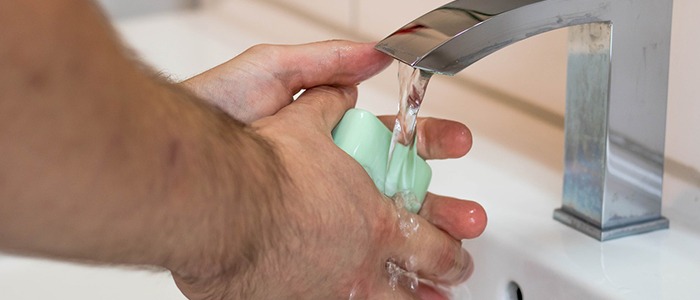The Easiest Way to Learn Spanish Reflexive Verbs
Spanish reflexive verbs are verbs that we use when talking about actions that we do to or for ourselves. They are often common Spanish verbs that are used in our daily routine, like getting dressed or taking a shower. They are also used when talking about emotions, like getting upset or bored.

What Do Spanish Reflexive Verbs Look Like?
All reflexive verbs end in –se, like “lavarse”. To conjugate reflexive verbs, first we conjugate the –se into a pronoun to fit who we are talking about. This pronoun goes before the verb. Then we just conjugate the verb like normal. Here is a list of the pronouns:
Pronouns
Yo me (myself) Nosotros nos (ourselves)
Tú te (yourself) Vosotros os (yourselves)
Él/Ella se (himself/herself) Ellos/Ellas/Ustedes se (themselves/yourselves)
Once you have the pronouns down, you just need to add the verb. Let’s look at a few common Spanish reflexive verbs that are sure to come up in everyday conversation.
Common Reflexive Verbs
Bañarse – to bathe oneself Lavarse – to wash oneself
Levantarse – to get oneself up Acordarse – to remember
Quedarse – to stay Enojarse – to get angry
Volverse – to return Sentirse – to feel
Aburrirse – to get bored Sentarse – to sit oneself down
Despertarse – to wake oneself up Vestirse – to get oneself dressed
Irse – to leave Quejarse – to complain
Examples
Now that you have the basic formula, let’s look at a few example sentences. Remember, the formula is:
Subject + pronoun + conjugated verb
Me baño. – I bathe (myself).
¿Te acuerdas? – Do you remember?
Ella se enojó mucho conmigo. – She got really mad at me.
No nos quejamos nunca. – We never complain.
Vosotros os levantáis temprano. – You guys get up early.
Ellos se quedan en la casa. – They stay at home.
The pronoun always goes directly before the verb, whether it is a negative sentence or a question.
Difference Between Reflexive and Non-reflexive Verbs
I’m sure you noticed a lot of the verbs from the list and recognized them without the -se ending. Yes, many of these verbs don’t always have to be reflexive. But what is the difference? Let’s look at the verbs “ver” and “verse”.
“Veo la pared” means “I look at the wall”, while “me veo” means “I look at myself”. The same goes for “lavar” and “lavarse”. “Él lava el carro” means “he washes the car”, while “él se lava las manos” means “he washes his hands (himself)”. In both of the Spanish reflexive verb examples, the subject is performing an action on him or herself.
A Few Things to Keep in Mind
Remember that if you are using a reflexive verb in a command, you must always include the pronoun. In positive commands, the pronoun goes after the verb and in negative commands it comes before.

¡Lávate las manos!
¡No te laves las manos!
¡Quítense los zapatos!
¡No se quiten los zapatos!
It is also important to note that depending on country the usage and frequency of reflexive verbs can be different. In Mexico, for example, it is very common to use reflexive verbs on words that normally wouldn’t be reflexive. Take the verb “comer” for example. You can easily say the sentence “comí unos tacos” and be understood. But likewise you could say “me comí unos tacos.”
Usually adding a reflexive verb where it is not required adds emphasis. Like, “I ate up the tacos,” instead of “I ate the tacos,” but in some countries this conjugation is very common and widely used.
Practice!
Now for some fun. Let’s have a look at those Spanish reflexive verbs in action with this song by Mexican pop singer Gloria Trevi. The song, “Me Siento Tan Sola,” is about a girl who finds herself unexpectedly pregnant and alone. Think Madonna’s “Papa Don’t Preach” but in Spanish.
tan solos los dos.
Me puse a temblar
cuando él se acercó a mí.
Pude sentir que no tendría voluntad,
apenas y dije no
y él me empezó a desnudar.Y me puse a llorar
poco después del final.
Sus ojos, su adiós
me dieron la verdad.
Pude saber que él no sería para mí
y yo si para él,
aunque nunca lo vuelva a ver,
aunque nunca lo vuelva a ver.
Poco tiempo después
tuve un nuevo temor,
mi cuerpo cambió
con una revolución.
Me cansé de esperar
lo que llega cada mes,
fue cuando comprendí
que algo crece adentro de mí.
y quisiera gritar
que me siento tan solaaaaaaaaa
que casi juro que mi ángel me abandonó,
que el sol me huye para no ver mi dolor
y mi mayor consuelo
me da tanto miedo,
se mueve y crece dentro de mi cuerpo…Y la casa tembló cuando papá se enteró
lo debes perder fue lo que él ordenó
pues la gran sociedad
no se debe enterar.
No me dolieron los golpes
tanto como mi soledad.
Ella también lo apoyo
en lo que él decidió
y me hicieron saber mil veces que les fallé.
Me cansé de escuchar
del honor que perdí,
lo que perdí fue un amor
más que más da si me siento mal,
qué más da si me siento mal…
If you want more practice there are two great songs by Colombian singer-songwriter Shakira that come to mind. Check out her classic song “Si Te Vas” and her newer hit “Me enamoré” for more Spanish reflexive verbs.
Learning Spanish from content you love
If you want go a step further while studying Spanish, check out LingQ.
LingQ is the best way of learning Spanish online because it lets you learn from content you enjoy! Whether you enjoy watching Spanish Youtubers, listening to podcasts, or reading blogs, you can import a variety of online content and create interactive lessons to help you study.
LingQ also comes with 1000s of hours of beginner content to help you get started.

Not only that, LingQ is available for iOS and Android, allowing you to take your lessons on the go!
If you want an easier and more enjoyable way to learn Spanish, give LingQ a try today. Grow your vocabulary, interact with a community of learners, ask for tips, and find an infinite amount of content to learn from.


